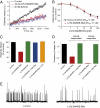SNARE tagging allows stepwise assembly of a multimodular medicinal toxin
- PMID: 20921391
- PMCID: PMC2964210
- DOI: 10.1073/pnas.1007125107
SNARE tagging allows stepwise assembly of a multimodular medicinal toxin
Abstract
Generation of supramolecular architectures through controlled linking of suitable building blocks can offer new perspectives to medicine and applied technologies. Current linking strategies often rely on chemical methods that have limitations and cannot take full advantage of the recombinant technologies. Here we used SNARE proteins, namely, syntaxin, SNAP25, and synaptobrevin, which form stable tetrahelical complexes that drive fusion of intracellular membranes, as versatile tags for irreversible linking of recombinant and synthetic functional units. We show that SNARE tagging allows stepwise production of a functional modular medicinal toxin, namely, botulinum neurotoxin type A, commonly known as BOTOX. This toxin consists of three structurally independent units: Receptor-binding domain (Rbd), Translocation domain (Td), and the Light chain (Lc), the last being a proteolytic enzyme. Fusing the receptor-binding domain with synaptobrevin SNARE motif allowed delivery of the active part of botulinum neurotoxin (Lc-Td), tagged with SNAP25, into neurons. Our data show that SNARE-tagged toxin was able to cleave its intraneuronal molecular target and to inhibit release of neurotransmitters. The reassembled toxin provides a safer alternative to existing botulinum neurotoxin and may offer wider use of this popular research and medical tool. Finally, SNARE tagging allowed the Rbd portion of the toxin to be used to deliver quantum dots and other fluorescent markers into neurons, showing versatility of this unique tagging and self-assembly technique. Together, these results demonstrate that the SNARE tetrahelical coiled-coil allows controlled linking of various building blocks into multifunctional assemblies.
Conflict of interest statement
Conflict of interest statement: Medical Research Council UK has filed a patent based on the described work.
Figures





References
-
- Yeates TO, Padilla JE. Designing supramolecular protein assemblies. Curr Opin Struct Biol. 2002;12:464–470. - PubMed
-
- Zhang S. Fabrication of novel biomaterials through molecular self-assembly. Nat Biotechnol. 2003;21:1171–1178. - PubMed
-
- Lehn JM. From supramolecular chemistry towards constitutional dynamic chemistry and adaptive chemistry. Chem Soc Rev. 2007;36:151–160. - PubMed
-
- Fernandes R, Roy V, Wu HC, Bentley WE. Engineered biological nanofactories trigger quorum sensing response in targeted bacteria. Nat Nanotechnol. 2010;5:213–217. - PubMed
Publication types
MeSH terms
Substances
Grants and funding
LinkOut - more resources
Full Text Sources
Other Literature Sources

